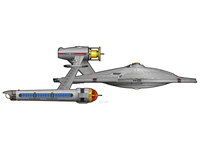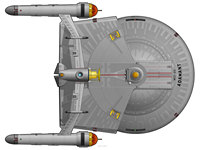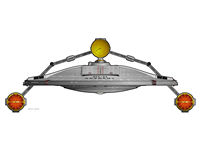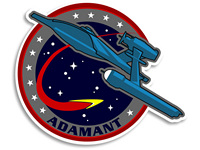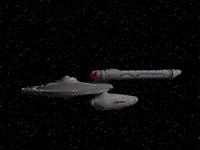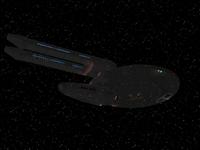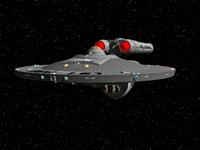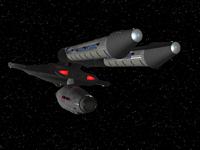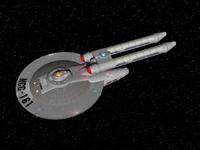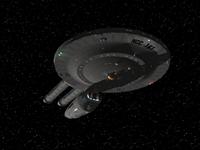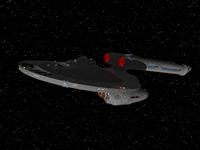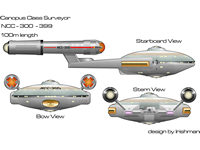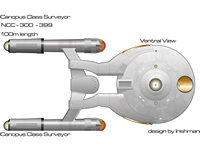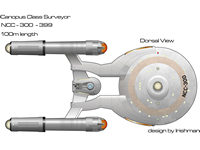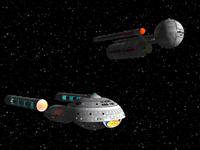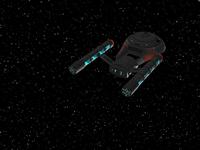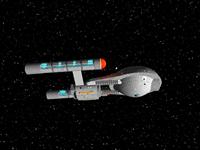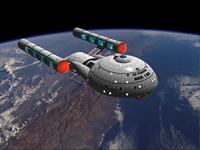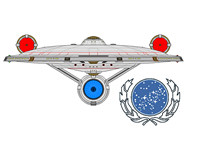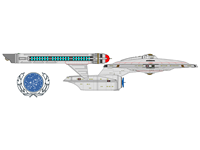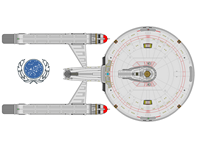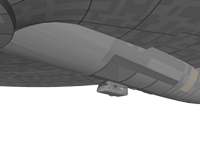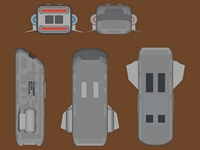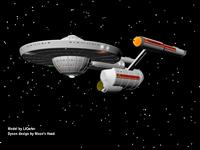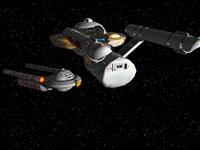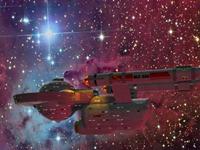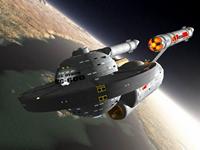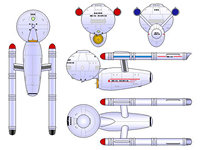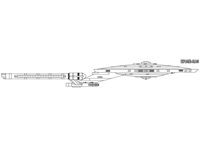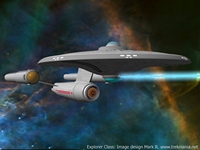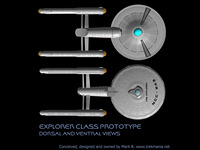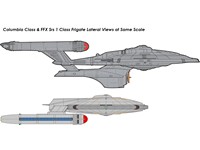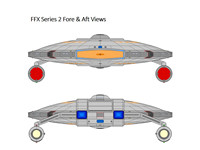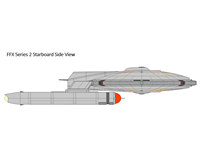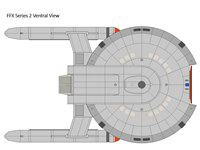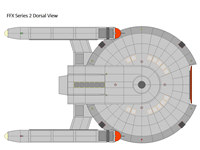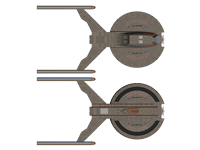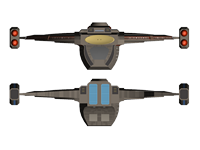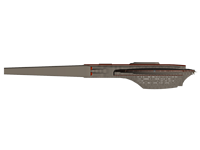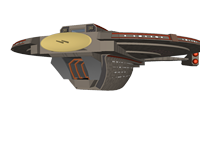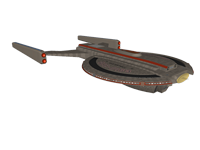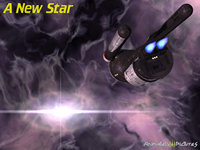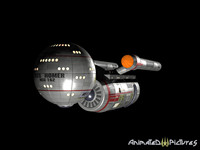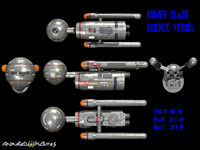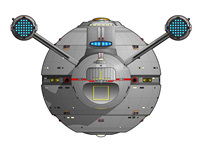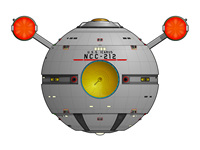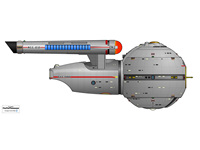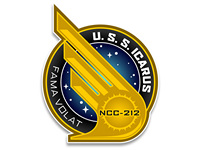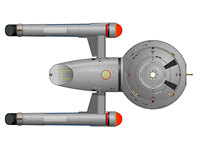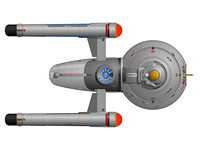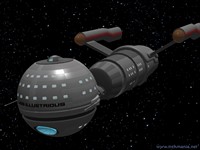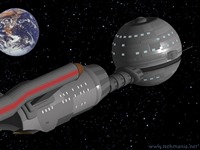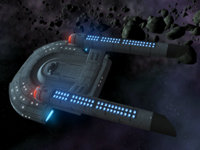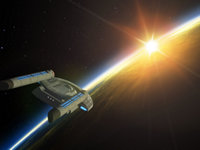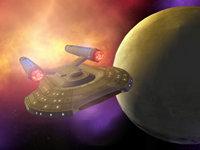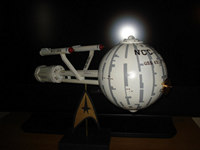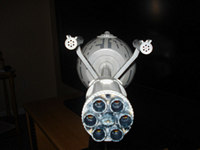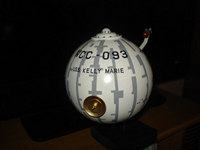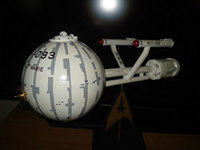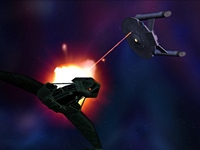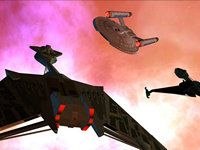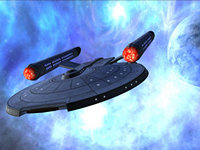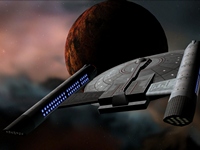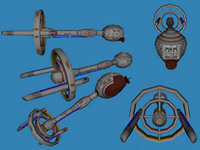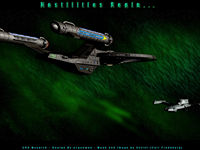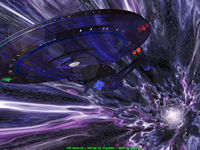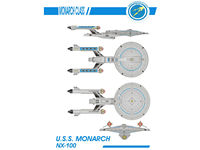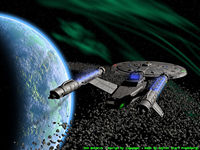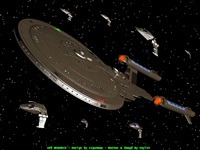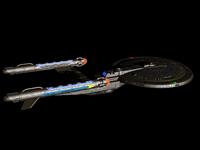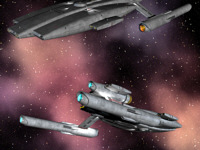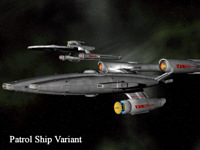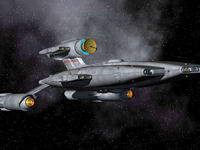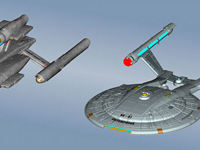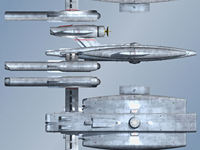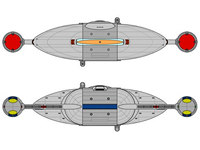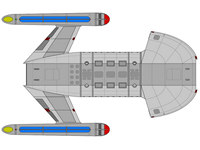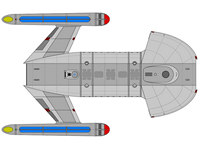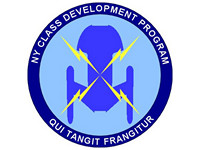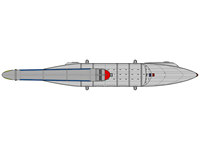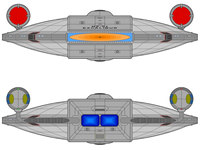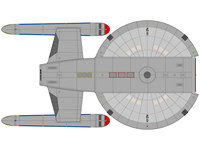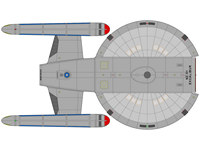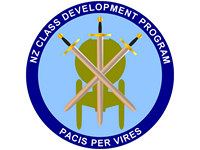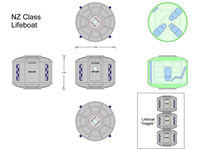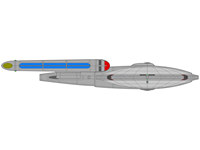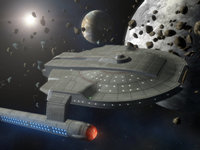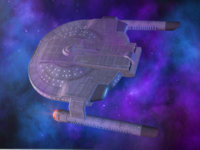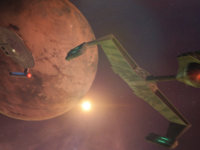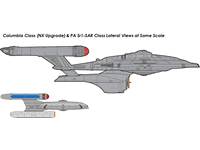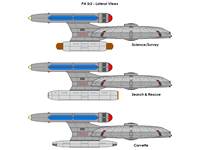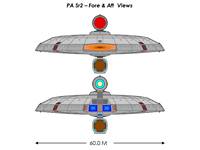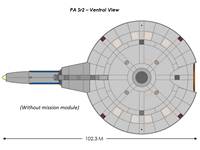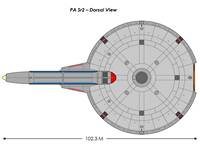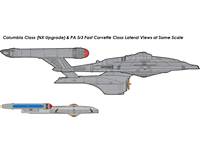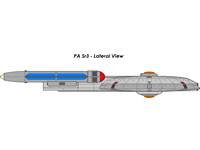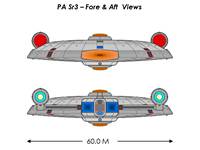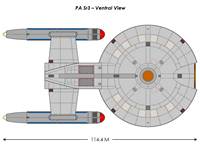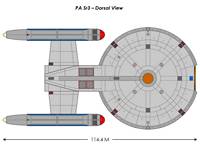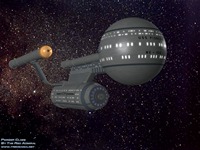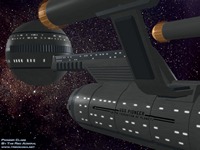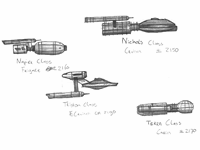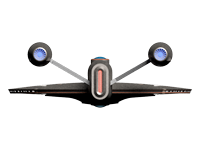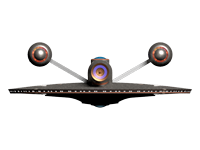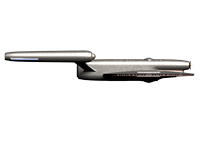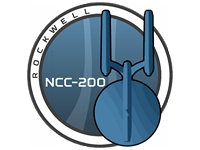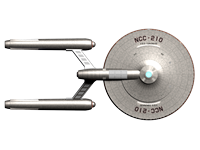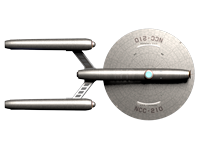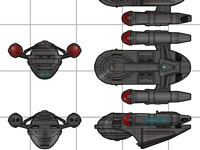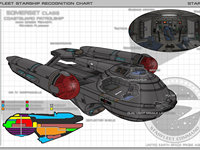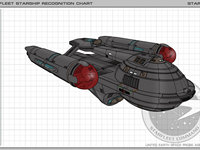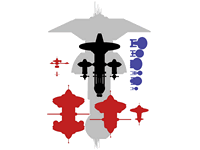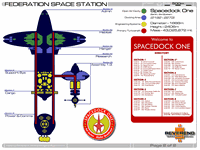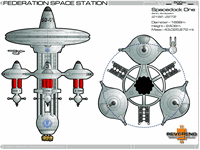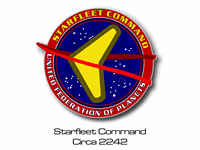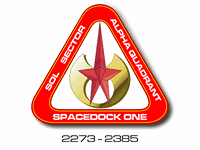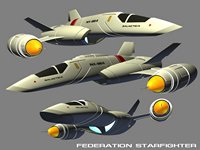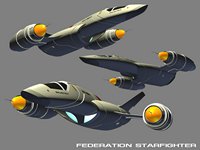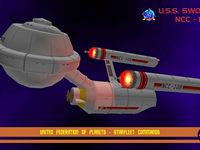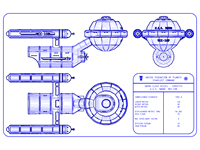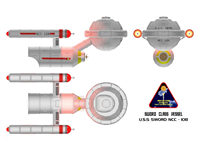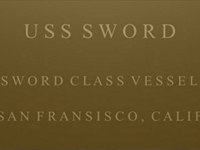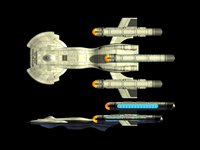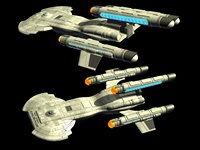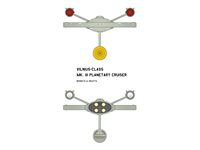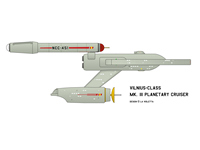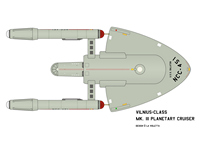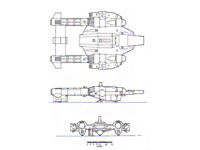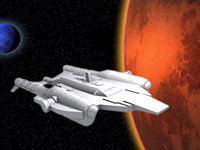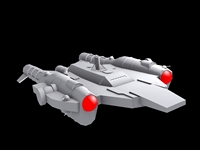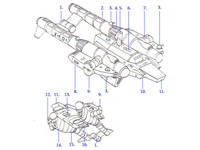22nd Century
History, 21st Century, 22nd Century, Early 23rd Century, Late 23rd Century, Early 24th Century, DY Starship Family
Adamant Class
Design by
M. Christopher Freeman
Type: Explorer
First commissioned: 2159
Length: 219m
Width: 183m
Height: 74m
Decks: 11
Complement: officers + 100 crew
Speed: Warp 4.5 (cruise), Warp 5.5 (max.)
Armament: 4 torpedo launchers, 4 laser cannons, 4 phase cannons
Defense: Experimental shield arrays
Embarked craft: 2 shuttlepods
Building on the successes of the NX class, Starfleet engineers began developing a new class of ship that would be the next step in the exploration of deep space. The Adamant class was born.
Adamant was especially suited to astrometry and exobiological study beyond the frontier of known space. Equipped with the latest long range sensor technology, a more powerful deflector array than most Starfleet ships its size, and stores large enough for a 5 year deep space mission, Adamant also touted larger labs and a more diversified science crew than previous Starfleet explorers. Early human exploration quickly discovered that the galaxy was a much more dangerous place than initially suspected. Beyond her scientific abilities Adamant was also armed with a wide array of defensive capabilities designed to get her out of any scrape. Armaments included two forward dual mounted torpedo launchers, two aft torpedo launchers, two dorsal and two ventral retractable laser cannons, and two forward and two aft pylon mounted phase cannons. She also sported experimental shield arrays fitted for field testing.
Ships of the class
- NCC-23 Adamant
- NCC-24 Relentless
- NCC-25 Courage
- NCC-28 Endeavor
- NCC-31 U.S.S. Resolute
- NCC-36 U.S.S. Adventure
- NCC-37 U.S.S. Dauntless
- NCC-39 U.S.S. Independent (refitted)
- NCC-40 U.S.S. Fearless (refitted)
- NCC-42 U.S.S. Valor (refitted)
The Adamant class had a scheduled 25 year ten vessel production run (2159 - 2184) and lifespan that lasted well into the early 23rd century.
Amundsen Class
Design by Nixon's Head
Type: Scout
First commissioned: 2158
Length: 189m
Width: 95m
Height: 52m
Decks: 14
Complement: 12 officers + 80 crew
Speed: Warp 5.5 (cruise), Warp 6 (max.), Warp 6.6 (max. emergency)
Sublight speed: 0.3c (max.)
Armament: 7 phase cannons, 1 photonic torpedo launcher
Defense: 8 plasma point defence guns, polarized hull plating, EM/subspace screens
Embarked craft: 6 shuttlepods
The Amundsen class was developed during the first two years of the Earth-Romulan war to meet the need for a fast, quick to build scoutship to serve as pickets for Earth fleets defending against their stealthy Romulan adversaries. Drawing heavily on the knowledge gained from over six years of flight experience with the NX-class, the Amundsen design used the same revolutionary three-stage plasma acceleration and symmetrical warp field governor technology married to a more modern, light-weight reactor design.
A major innovation of the Amundsen-class was to move the warp nacelles into close proximity to take advantage of the constructive field interference to produce a more powerful asymmetric field for forward flight whilst reducing the forward cross-sectional area exposed to subspace drag. Although manoeuvrability was severely, this configuration allowed for much faster straight-line speeds than would otherwise be possible, something that proved to be a saving feature again and again as Amundsen-class ships outran pursuit to bring vital news of enemy fleet movements to the Allied Command. The success of this approach was further demonstrated by the development of later single-nacelle ships, which remained Starfleet's preferred configuration for scouts into the 24th century.
Production of the Amundsen-class continued after the war to meet the need for fast scouts to monitor the new Neutral Zone, a mission for which the Amundsen was a mainstay before the construction of permanent monitoring stations was completed. Pictured is the starship Weyprecht in her Federation Starfleet colours. Launched in 2159, the Weyprecht went on to serve as a ship of the line for 45 years before being decommissioned and sold to a private exploration cooperative in 2204. She disappeared in 2207 whilst on a deep range mission to the Joseph cluster.
Canopus Class
Design by Irishman
Type: Surveyor
First commissioned: 2171
Length: 100m
Width: 48m
Height: 20m
Decks: 6
Displacement: 112,000t
Complement: 4 officers + 24 crew
Speed: Warp 4 (cruise), Warp 5 (max.), Warp (max. emergency)
Sublight speed: 0.4c (max.)
Armament: Phase cannon emplacements (4)
Defense: Energy shielding
Embarked craft: 2 shuttlepods, one observation pod
After the UFP foundation in 2163, the new polity needed some way to visibly project their identity as a collective to others in their shared field of influence. Thus the idea of the unified fleet was born. The fleet was conceived as a unifying symbol of the UFP as a whole. The four classes of ships that made up the first fleet were chosen after long analyses of current ship numbers, usage, both commercial, scientific, and military among the component members. It was determined that 4 distinct classes of ships would be most practical to complement the already-existing fleets of the member worlds. These were the cruiser, corvette, surveyor, and tanker/transport.
The Canopus class surveyor was conceived as a way to fill in the immense spatial blanks that existed within UFP space. Featuring powerful mapping and other types of instruments, the surveyor was designed to quickly travel to those areas of unknown space and complete the knowledge of planets, lifeforms, and resources there. It was crewed by 28, with a supplementary scientific team of 16. It began service in 2171. Designed predominantly by a human team, the Canopus class bears more than a passing resemblance to the ill-timed NX class. It was determined early on that it would save development and prototyping time to borrow or adapt as many components or design ideas from the older vessel as possible. Indeed, the basic spaceframe was ready for core startup in December of 2168. Its deployment was delayed by the delicate and still unproven incorporation of certain alien technologies (namely Vulcan energy shielding and Tellarite navigation systems). Once commissioned, the Canopus class began a production run of 18 vessels, all serving UFP interests in such a distinguished fashion that the class pathfinder vessel (U.S.S. Canopus NCC-300) is on display at the Starfleet Museum to this day.
Ceres Class
Design by Nixon's Head
Type: Explorer
First commissioned: 2163
Length: 144m
Width: 58m
Height: 32m
Decks: 10
Displacement: 142,000t
Complement: 27 officers + 75 crew, evacuation limit: 300
Speed: Warp 4 (cruise), Warp 7 (max.), Warp 7.2 (max. emergency)
Sublight speed: 0.4c (max.)
Armament: 1 photonic torpedo launcher. 2 phase cannons.
Defense: Light energy shields derived from Vulcan technology.
Embarked craft: 2 standard shuttlepods, one Type-Beta shuttlecraft, one workpod.
The Ceres-class was an early attempt to develop a joint starship design amongst the member worlds of what would become the Federation. Instigated by the United Earth government shortly after the 'Coalition of Planets' summit in 2154, the Ceres project was intended to serve as a symbol of co-operation amongst the members of the new alliance, drawing on technical expertise from Earth, Vulcan, Andoria and Tellar. As the new allies were still not entirely at ease with one another, the Ceres was to be only lightly-armed, with it's primary role being exploration. The following years would see political pressures diffuse the effort slightly, so that in practice Ceres became a primarily Earth-Vulcan project, with relatively little input from Andoria and Tellar.
The engineering team at San Francisco took as their starting point the enormously successful NX, or 'Enterprise' class that had been the first Earth ships capable of Warp 5. The new ship would be larger than the NX, incorporating some Vulcan warp and shielding technologies.
One of the first changes proposed was a remodeling of the ship's subspace dynamics. The NX class had built on the work done on earlier ships like the Intrepid and used a compressed disk-like primary hull. This was a departure from earlier Earth ships like the DY-1200, but a refinement of warp-theory had given rise to computer models that suggested a saucer-like hull would allow for a higher degree of warp field efficiency. However, experience with the Intrepid and Enterprise demonstrated that the current generation of warp coils and flow controllers could not maintain precise enough control over the warp field for these efficiency benefits to materialize, and in fact that the combination of these coils with the compressed hull actually worsened subspace drag. It was anticipated that future advances in warp drive technology would one day make saucer-like hulls worthwhile, but until that time a return to a more spherical arrangement would give greater gains in engine endurance. As such, the primary hull of the Ceres was expanded in the z-axis, a change which had the beneficial side-effect of giving a larger internal volume for the ship's new experimental systems.
The warp nacelles were remodeled, with Tellarite fabrication techniques allowing for a much greater precision in warp coil forging, resulting in significant efficiency savings. Further power improvements were obtained by moving the warp core into a small secondary hull, giving a more direct route for drive plasma to reach the nacelles, reducing power losses from MHD cavitation.
One area that was substantially remodeled was the auxilliary spacecraft support facilities. The launch bays of the NX-class had been highly specialised, and were only truly compatible with Earth shuttlepods. The extra room in the Ceres' primary hull enabled the inclusion of a more spacious "hanger deck" that would permit auxiliary craft from all allied fleets to embark.
Development of the Ceres initially proceeded quite rapidly, and was further accelerated by the start of the Romulan War, when it was hoped that the technology transferred as part of the project could be applied in support of the war effort. The project continued after the war, but many of the engineers did not return, instead being diverted to the new Daedalus project. As with Ceres, Daedalus was to be a joint Allied design, although it was hoped that lessons learnt from the war and from the advances made on the Ceres project would allow a more compact but deeper range starship. Daedalus would incorporate many of the lessons learnt in the Ceres project, and make even greater use of non-human technologies.
With the inauguration of the United Federation of Planets in 2161, the Earth Starfleet was folded into the new Federation's Starfleet. The Starfleet was at first to be based on units seconded from the member planets' fleets for short tours of duty, but Federation leaders wanted to replace these with a new fleet of dedicated starships as soon as was possible. Starfleet put out a request for proposals, and both the Ceres and Daedalus were selected for further development.
2164 saw the launch of USS Daedalus. Slightly smaller, but more advanced than Ceres, and with a greater input from the non-human member worlds, the Daedalus was technologically and politically superior to the Ceres. Starfleet quickly chose the Daedalus as its preferred deep-space patrol ship, and Federation funding for the Ceres was withdrawn. The Daedalus was quickly joined by sister ships USS Essex (NCC-173), USS Horizon (NCC-176) and USS Archon (NCC-189), and the design would form the backbone of Starfleet for the next several decades.
Despite the ending of Starfleet interest in the class, the Ceres was not simply abandoned. Following the absorption of the Earth Starfleet into the Federation Starfleet in 2161, the United Earth Space Probe Agency had nonetheless continued semi-autonomously as Earth's main independent scientific space research organization. Wishing to keep their role separate from the quasi-military Starfleet, UESPA took up the Ceres design for its new generation of deep space explorers. Six Ceres-class ships were ordered by UESPA over the following decade, although the final ship (designated NAR-199) was cancelled before construction was completed. Nominally operated by UESPA, these ships also formed part of the Starfleet Reserve Force and were available to be called up for active duty in the event of a Federation State of Emergency. In practice a full call-up was never issued, although there were several instances of Ceres-class ships being temporarily seconded to Starfleet for survey or diplomatic courier missions when main fleet units were unavailable.
Class list
- USS Ceres NX-112 (later re-registered as SS Ceres, NAR-112) launched 2163
- SS Ida NAR-159 launched 2165
- SS Itokawa NAR-166 launched 2165
- SS Hidalgo NAR-191 launched 2166
- SS Gaspra NAR-195 launched 2167
- Un-named NAR-199 cancelled 2168
Thanks to Kris for permission to use his UESPA logo on the Ceres.
Coalition Class 
Design by Eric L. Gardner Jr
Type: Cruiser
First commissioned: 2190
Length: 292m
Width: 144m
Height: 57m
Decks: 14
Displacement: 85000t
Complement: 100 officers + 83 crew, evacuation limit: 75
Speed: Warp 6 (cruise), Warp 7 (max.), Warp 8 (max. emergency)
Sublight speed: 0.99c (max.)
Armament: Phased cannons, pulse cannons, photon torpedoes
Defense: Polarized hull plating, deflector shields, tractor beams
Embarked craft: Shuttlepods, escape pods, experimental long-range shuttlecraft
Built in the 2190's, the Coalition-class was Starfleet's latest starship design taken from and used parts of one of the proposed refits of the NX (later renamed Explorer) class. There were other ships of this design in service, including the U.S.S Yamato (launched in 2199). In 2205, the Coalition herself came under attack by an Romulan prototype warbird launched by those to refuse to accept the outcome of the war in Earth's favor. The Coalition was left adrift until a few of the Daedalus-class ships (the lead vessel being the Essex) towed their savior back to Earth. The Coalition was damaged beyond and was sent to be scraped...but the design itself would ultimately pave the way to more advanced ship designs.
The Coalition class would last until the 2240's when the Four-Year War with the Klingons began to attack Federation convoys to nearby colonies. The remaining Coalition models were sold or decommissioned by Starfleet to pave the way for a new starship design - a heavy cruiser that would later become Starfleet's beloved symbol of space exploration: The Constitution-Class.
Concord Type
Design by Terranimperial
Type: Shuttlepod
First commissioned: 2185
Length: 8.25m
Width: 4.9m
Height: 2.5m
Decks: 1
Complement: 1 officers + 4 crew
Speed: Warp 1 (cruise), Warp 2 (max.), Warp 2.5 (max. emergency)
Sublight speed: 0.25c (max.)
Armament: 2 forward phaser turrets
Defense: Polarized hull plating
The Concord Type Shuttlepod was developed alongside the Rockwell class. For all intents and purposes it was essentially a replacement for the NX type pods introduced decades earlier.
The Concord Types unlike their predecessors, were equipped with a limited warp drive. The class featured two impulse drive units. Two stabilizing units flanked the warp nacelles, allowing for smooth atmospheric flight. Due to their shape, the Concord Types were sometimes referred to by star fleet crews as Flying Bricks. On the inside the cramped interior was sometimes compared to a closet. Emergency medical supplies were behind panels on the side of the cockpit.
These shuttlepods were usually stored in the underside of the hull on a Rockwell Class starship, which typically had enough room for six.
Dyson Class
Design by Nixon's Head
Type: Cruiser
First commissioned: 2181
Length: 206m
Width: 96m
Height: 64m
Decks: 17
Complement: 30 officers + 270 crew
Speed: Warp 4 (cruise), Warp 7 (max.), Warp 7.2 (max. emergency)
Sublight speed: 0.3c (max.)
Armament: 3 phase cannons, 7 lasers, 2 torpedo tubes (AM-lithium warheads)
Defense: Frequency-adaptive shields
Embarked craft: 5 shuttlecraft
Starfleet's Daedalus-class ships had proved themselves capable explorers, but suffered from several problems. The first of these was the extremely small habitable volume, which limited crew size and forced those crewmembers aboard to endure cramped conditions for long duration patrols. Another problem was that the range of the subspace transmitters installed was often not equal to the operational range of the ships, meaning that several Daedalus-class vessels were lost whilst outside of FTL communications range. Finally, being primarily ships of science, the Daedalus' lacked the firepower needed to project Federation power into the distant regions they charted, or even for the type of self-defence that was often necessary when contacting alien species.
Starfleet tried to address some of these problems with a series of re-fits in the early 2170s. Starting with the USS Winchester (NCC-291), the Daedalus-class ships were overhauled to mount as many systems as possible externally to the pressure hull. These refits did much to extend the usefulness of the Daedalus, but it was seen as more of a stop-gap measure than a final solution. In addition, there was an increasing push from both federalists within the Federation Council and 'hawks' within Starfleet to improve the Fleet's military capabilities with a new, powerful joint cruiser design. This would reduce Starfleet's reliance upon the member worlds for military assets and give the central government greater flexibility over deployment of those forces.
In 2172 the Federation Council officially authorized the development and procurement of an initial batch of ten "Exploration-Cruisers" based on Starfleet's "Project Dyson" design studies.
The Dyson design continued the concept of the Winchester for mounting as many automated systems as possible in an external disk structure, whilst retaining the maximum habitable space within a spherical primary hull. Operational experience with the Daedalus refits had shown that such an external arrangement often had the disadvantage of complicating repairs when systems in the ring went wrong - the lack of internal access meant that lengthy spacewalks were often needed for even simple repairs. Because of this the Dyson design included a series of pressurized Jeffries tubes within the primary hull's disk. These allowed shirtsleeve access to most of the systems in the disk whilst keeping the bulk of the habitable volume in the sphere free for other uses.
The navigational deflector system was moved into a separate pod in the secondary hull, maintaining a clear line of sight in the direction of travel whilst allowing more direct access to the warp core (contained in the secondary hull), increasing deflector output by around 15%.
The warp drive system had a new reactor design that allowed a much finer control over the output warp plasma than was possible in earlier engines, allowing the theoretical efficiency savings of a disk-shaped hull in the warp-field's forward lobe to begin to be realized. Although still limited to a maximum of just over Warp 7 by the "time barrier" (the energy barrier which later theories would show to be the Warp 6 peak transition threshold on the recalibrated Eugene-scale), this breakthrough in subspace dynamics nevertheless gave a substantial increase in un-refueled range. It also considerably reduced the stresses on the warp core, something which many had blamed for the high mortality rate of the Daedalus-class.
Advances in energy shielding made modern deflectors significantly more effective against phase weapons. Similar advances by perceived threat forces led to phase cannons being downgraded to a secondary offensive role, to be overtaken by high-energy tunable lasers. Lasers had the advantage that they could dynamically adjust their frequency to pass through the narrow EM windows that existed in contemporary energetic shields - windows that the broad-spectrum phase cannons could not effectively penetrate. Although limited to use in sublight operations, lasers kept this advantage over other directed energy weapons until the development of modern phasers in the early 23rd century. For this reason, the Dyson was to carry only three phase cannons, whilst mounting a total of seven laser cannons.
Photonic torpedoes had shown themselves to have enormous destructive potential when rushed into service during the Xindi crisis, but problems uncovered in the 2160's with effective warhead annihilation and safe long-term storage meant that Starfleet deemed them too immature a technology for front-line use. Antimatter-initiated lithium fusion missiles in the multi-megaton range remained Starfleet's heavy-hitting warp-capable weapon of choice into the 2180s, with Dyson-class ships initially being fitted with only a small complement of photonic warheads for specialized use.
Development of the Dyson-class continued through the 2170's, culminating in the launch of the lead ship in October 2179. Following two years of trials, the USS Dyson was formally commissioned into Starfleet service with the permanent registry NCC-600. A further nine ships were launched over the next three years, with a second batch of eighteen vessels delivered between 2186 and 2189. A final batch of three ships was produced in 2196 to replace the loss of the starships Cochrane, Sagan and Zubrin.
Starting with the Dyson herself in 2199, some of the earlier ships underwent an extensive refit. This refit saw the warp drive upgraded and a widening and flattening of the primary hull saucer, made possible by advances in subsystem miniaturization and the deletion of the primary hull's deuterium tanks. Some VIP quarters and crew facilities were moved to the rim of the saucer, where large windows were fitted to give a splendid unobstructed view of the outside universe. Defensive systems were also updated, with the removal of all phase cannons and their replacement by a new pulse laser cannon that provided short bursts of extremely high power laser energy designed to punch through shields before they had time to react.
USS Kepler, NCC-835, was the last Dyson-class vessel to be retired by Starfleet in 2240.
Thanks to LtCarter for his rendering of the re-fitted Dyson-class.
Endeavour Class
Design by Steve Yousten
No specs available
The Endeavour class has about the size and crew complement of the Daedalus, it has an ejectable warp core, as well as an emergency antimatter venting port (bottom rear), weapons turrets above and below the main hull, with a shuttle deck in the middle. It also has three stacked "bridges" -- a main bridge, an ops bridge above it, and a science bridge below. They are connected by elevator, as well as ladders (like on submarines).
Explorer Class (1)
Design by Chris Talbot
Commissioned: 2197-2223
Length: 263m
Beam: 139m
Height: 35m
Decks: 11
Mass: 420,000mt
Crew: 345
Speed: Warp 5.5 (cruise), Warp 6.5 (max.)
The Explorer class is designed to bridge the gap between NX class and Consitution class, showing a clear design lineage.
Explorer Class (2)
Design by
Mark, ASDB Member
Type: Surveyor
Commissioned: 2196-2244
Length: 271m
Decks: 13
Mass: 1,250,000mt
Crew complement: 390
Speed: Warp 5.2 (old scale)
The Explorer class was one's typical long range explorer, replacing the likes of the ageing Daedalus and Gagarin classes that went before it. A major step forward in weapons research at around this time saw this class as the prototype for first elementary rapid nadion phaser arrays. Even though many times less powerful than one of today's Galaxy-class emitters, they still provided a significant advantage in both energy efficiency and power output (about a megawatt), compared to the earlier phaser cannons that endured for the previous couple of decades. Another interesting thing of note, the dedication plaque on the USS Explorer bridge read, "A swift wind for those on foot, at sea, or in the firmament, who seek out new life, and new lands...." This was a twist of the famous words, first spoken by Dr Cochrane: 'to boldly go where no man has gone before,' and 'to seek out new life and new civilisations...' This philosophy embodied the original Starfleet charter, a directive which dominated the principle behind the Federation's expanding charter going into the 23rd century.
FFX Class
Design by Steve Justice
Type: Frigate
First commissioned: 2180
Length: 164.3m
Width: 100.0m
Height: 33.4m
Decks: 5
Complement: 20 officers + 64 crew
Speed: Warp 5.5 (cruise), Warp 6.5 (max.), Warp 7.0 (max. emergency)
Armament: 8 MkIII dual mount pulsed phase cannons, 4 torpedo tubes (2 fwd & 2 aft) with 72 MkIII photonic torpedoes
Defense: Hoplon M4 shield generators & polarize hull plating
In the early decades of the United Federation of Planets, the member systems provided ships and crews to serve under the combined Star Fleet Command. Although the allied systems had shared much in technology and tactics, it would take decades for a truly unified fleet to emerge featuring common ship designs. In the interim period each member system continued to produce their own ship designs to meet Starfleet requirements, albeit with increasing levels of technology transfer.
While each Federation member contributed to the major cruiser classes, the Federation assigned the various other fleet duties among the members with Earth assigned the task of providing ships for protection and policing of space lanes between Federation star systems. This resulted in the Patrol/Auxiliary (PA) class Series 1 and 2 built to fill three critical mission areas; namely space lane protection, search and rescue, and science/survey. Later the same design team used the core PA components and technologies to develop the PA Series 3 Fast Corvette Class. When Starfleet issued a request for a new class of mid-size general purpose starships, Earth stepped forward to provide this new class
Riverside Yards, which led the earlier NZ and PA class developments, submitted a design that incorporated operational experience from those classes combined with the latest levels of Earth technology and technology transfer from Federation member worlds. The new class would be smaller than the contemporary Columbia cruiser class to reduce construction and operating costs, but would be able to fill a number of mission roles including exploration, commerce patrol and enforcement, diplomatic missions, and escort.
Since these missions mirrored the roles served by the sailing frigates of Earth during the 18th and 19th centuries, the new design was rated a 'frigate' hence the development designation of FFX.
Building on the NZ and PA design experience, the FFX design studies started in 2175 focusing on creating a well-balanced design that would be a "jack of all trades" for Starfleet. Much emphasis was also placed on minimizing cost and the crew requirements with the resulting design providing a very flexible ship with strong tactical capability along with good science/survey, exploratory, and space lane patrol capabilities.
Starfleet issued construction contracts in 2177 for 6 FFX ships with production beginning soon after the completion of the PA Series 3 construction program in 2178. Starfleet ordered an additional 8 FFX ships in 2182 after the very successful fleet trials of the first two FFX ships. The major ship components were built at the existing construction facility at the Riverside Yards, matter/anti-matter reactor assembly and warp nacelles supplied by Cochrane Warp Dynamics of Alpha Centauri, with final assembly, checkout, and launch from the Starfleet San Francisco Yards.
As the second order of frigates were under construction, Riverside Yards offered an upgraded design using the latest in warp engine technology and other updates that would improve the overall efficiency of the design. Based on the success of the class and the promised improvements, Starfleet ordered an additional 8 ships. The original 14 ships were retroactively designated as Series 1 with the newer 8 ships as Series 2.
During Starfleet's transitional early period of integrating the various Federation member fleets and registrations, Earth-built ships received both a Earth designation and a Federation naval construction code (NCC). These ships were classified as frigates (FF) with the names for each ship taken from sailing frigates of Earth's major navies of the 18th and 19th centuries.
The first ship, Constellation, was launched in 2180 and entered the fleet in 2181 after an exhaustive test program. The additional 13 Series 1 ships followed in approximately nine-month cycles over a production span of 10 years. The first Series 2 ship, Adventure, was launched in 2191 with the last Series 2 ship launched in 2196.
Five Series 1 ships were converted to a Medical Frigate variant, designated FFM, between 2195 and 2197.
Design philosophy
The FFX design focused on a balance of capabilities usually only seen in the large and expensive exploratory cruisers, but in a more compact and less expensive package. The external layout of a main saucer with under-slung warp nacelles set the mold for future frigate classes well into the next century.
All internal systems were extremely reliable benefiting from experience in the earlier NZ/PA classes combined with latest warp 7 propulsion systems and other technologies from Federation member worlds. While not best-in-class in any one area, the FFX did have excellent integration of systems. The FFX class also had expanded endurance and updated crew accommodations to account for ever expanding Federation space.
The design also continued the Riverside Yards philosophy of less complex external hull geometry and simplified internal structural layouts to reduce the overall parts count. Each saucer outer hull section was used in a minimum of four locations while some sections were used in up to 22 locations to greatly reduce the manufacturing complexity and cost.
The internal deck arrangements were simplified to ease the routing of power and control system conduits and inter-deck passages. In addition the ships featured multiple back-up fusion reactors (six) for maximum redundancy and reliability.
The saucer was divided into six decks, with the Bridge (Deck 0) located in the traditional location at the top dorsal position on the saucer. One turbolift linked the Bridge with the other decks, a personnel turbolift and separate cargo turbolift served decks 1-4, while other lifts and ladder ways were located throughout the saucer section to allow easy movement between decks even in the absence of main power. The saucer had 30 escape pods which could accommodate up 120 crew.
Maximum sustained speed for FFX class ships was warp 6.5 with a brief period of warp 7.0 in emergency conditions. Standard cruising speed was warp 5.5.
The FFX Srs2 ships were 164 meters in length with a beam of 100.0 meters with a maximum draft of 33.4 meters along with a maximum mass of 67,000 metric. The normal ships complement was 84 standard (20 officers, 64 enlisted) with a maximum crew complement of 100 temporary mission specialists.
Operational history
As anticipated by the designers, the FFX Class Frigates were assigned to a wide range of missions across their service lives. The mix of capabilities of the FFX class led them to be assigned in a number of sectors in lieu of cruisers to maintain a Starfleet presence as the Federation continued to expand. The FFX class also became task force leaders for convoys and colonization missions to the edges of Federation space.
Another key role that emerged was supporting "cycle traffic" of diplomats and diplomatic cargo between member systems and to the Federation Headquarters on Earth. As newer starship classes came into service, many of the FFX ships were home ported at the key Federation member worlds to provide a consistent Starfleet presence. By the early 23rd century FFX ships were a familiar sight within the Federation interior and seen only sparingly at the frontier.
To better serve these cycle traffic missions, the guest quarters were upgraded along with shuttle bay systems to support the particular shuttle types used by the home port government. During this period postings to the FXX ships were not highly regarded by many Starfleet crew, but the officers did receive excellent experience in diplomacy while serving on an FFX which served them well on later postings to exploratory ships making first contacts.
Only one ship was lost in service, the Constellation (NCC-320), disappearing in 2193 during a deep space patrol mission for reasons unknown. The Guerriere (NCC-347) was heavily damaged in action with Orion pirates in 2211, leading to early decommissioning in 2212.
The FFX class proved to be extremely reliable ships with an over 35-year service life with Series 2 ships serving more than 40 years. The FXX set the template for frigate design and layout that lasted well into the 23rd century. The last Series 2 ship retired, Independence (NCC-377), was home ported in the Alpha Centauri system and was preserved for display at the Alpha Centauri unit of the Starfleet Museum.
With expansion of the Federation a need emerged for a fast ship to provide rapid reaction medical assistance to distant locations; to address this need five of the FFX Srs1 ships where converted to Medical Frigates (FFM) from 2195 to 2197. The FFM conversions were very useful ships and stayed in service well past their other Srs1 contemporaries until final decommissioning of the entire FFX fleet in 2236.
Harcourt Class
Design by Terranimperial
Type: Explorer
First commissioned: 2175
Length: 340m
Width: 180m
Height: 48m
Decks: 12
Complement: 100 officers + 300 crew, evacuation limit: 800
Speed: Warp 5 (cruise), Warp 6 (max.), Warp 6.5 (max. emergency)
Sublight speed: 0.2c (max.)
Armament: 8 single emitter phaser banks, 4 photon torpedo launchers
Defense: Polarized hull plating, directed shielding (2187 refit)
A class of starships introduced in 2175. NX-150 was the class leader. The Harcourt class was 340 meters long. It remained a contemporary of the Rockwell class ship introduced ten years later. It was capable of landing on planetary surfaces. The class was not considered a true successor to the NX-class, and was in fact less advanced in some ways. The Harcourt class did however, have the most advanced sensor capabilities in Starfleet at the time, surpassing anything the Rockwell class possessed. The sensors on Harcourt class made it well suited for exploration and surveying space. The Harcourt class had a minimal armament to emphasize on its exploratory purpose.
Some Harcourt class ships were in the process of undergoing refits to include shield technology and more advanced weaponry as seen on the Rockwell class in the year 2187.
The class had a unique arrangement among Starfleet ships, with the bridge being an armored command center located on the fore end of the saucer, instead of the center. The class also featured spacious shuttlebay, compared to the cramped and small individual launch bays on other classes such as the NX and Rockwell. The class was the one of the largest classes in the fleet, mostly because of the huge Warp Core and computer core.
The USS Edgedancer (NCC-185) was one of these ships. This vessel was famous for it's mysterious destruction above Kaferia in 2187. the crew of the USS Coronado's analysis of the data collected from Edgedancer's sensors proved vital to proving that the Federation was not under attack by the Romulans, thus averting yet another interstellar war.
Based off of multiple designs including the NX class, the Shenzhou and the USS Discovery
Homer Class
Design by Andreas Koch
No specs available
The Homer class is an early Federation science vessel. Based on the Daedalus-ships it has still some differences. First is the larger secondary hull. Therefore it can hold larger amounts of fuel, cargo and of course crew. Either that way, or the crew quarters are more comfortable.
Other differences are found at the primary or command hull. The bridge moved from the middle to the top of the command section. The main sensor domes ar now located at the bottom of the primary and at the front of the secondary hull. The Homer also has two shuttlebays contrary to the Daedalus class: one large one at the end of the engineering section and one in the command section going through the whole deck. In addition, the Homer features an experiment: escape pods. The most visible difference, however, are the large impulse engines. Therefore the ship is able to reach higher sublight speeds than its predecessor and that also faster. The Homer class is a pure science vessel and therefore has no weapons.
Icarus Class (3)
Design by M. Christopher Freeman
Type: Surveyor
First commissioned: 2188
Length: 112m
Width: 65m
Height: 49m
Decks: 11
Displacement: 115000t
Complement: 17 officers + 102 crew
Speed: Warp 4 (cruise), Warp 7 (max.), Warp 8 (max. emergency)
Sublight speed: 0.5c (max.)
Armament: 4 dorsal & 4 ventral phase cannon banks, 2 forward & 2 aft photon torpedo tubes
Defense: Deflector shield array
Embarked craft: 4 Type-A3 shuttlecraft, 2 experimental X-104 Wasp fighter craft
Development notes
The Icarus was originally commissioned as a replacement for the aging Daedalus class. Starfleet engineers developed her as a multifunction ship primarily suited for long-term deep space survey and "second contact" diplomatic missions on the frontier of known space. She is equipped with the latest sensor technology and a deflector array that can also be used as a large sensor platform to carry out survey or picket missions.
Her primary function is to serve three-year or longer semi-autonomous missions beyond contact with Starfleet. The ship has a large cargo bay for both mission cargo and trade goods. The trade goods allow restocking with local planetary inhabitants when supplies run low. Along with the galley and protein resequencers she touts extended ships stores for preservation of food and water, and hydroponics equipment that can easily be set up in the event of a dire food shortage. An extensive machine shop was also added for parts service and fabrication of replacement parts for almost any system on board the ship deep in the frontier where space dock facilities would be a luxury.
Because of the heavy armaments for a ship her size, in times of political dispute or all out war she can be outfitted as a frigate for light combat and escort duty and because of the advanced sensors she can also serve as a picket ship in larger fleet maneuvers. The Icarus carries two newly developed experimental Wasp fighter craft for final field-testing on the frontier, the X-104/G (Krazy Kat) and X-104/H (Ignatz Mouse). X-104/G is armed with standard Starfleet phase weapons and sensors; X-104/H is a test bed for the experimental dilithium-focused laser and a compact long-range sensor system. The "H" is also equipped with a pair of the newly developed small craft Bussard collectors.
Lineage of the Icarus class
The Icarus class served Starfleet with distinction through more than 50 years and two refits. The last surviving Icarus class vessel, the U.S.S. Heracles was decommissioned in 2242 and is on display at Smithsonian Institute Spaceflight Museum in orbit at Earth. Below is a complete list of ships of the class.
- NCC-212, U.S.S. ICARUS (Commissioned 2188)
- NCC-218, U.S.S. HYLAS (Commissioned 2189)
- NCC-219, U.S.S. CEPHALUS (Commissioned 2189)
- NCC-238, U.S.S. ENDYMION (Commissioned 2191)
- NCC-256, U.S.S. ELECTRA (Commissioned 2193)
- NCC-260, U.S.S. SISYPHUS (Commissioned 2194)
- NCC-279, U.S.S. ADONIS (Commissioned 2196)
- NCC-282, U.S.S. PYRAMUS (Commissioned 2196)
- NCC-301, U.S.S. ACHILLES (Commissioned 2198, refitted 2204)
- NCC-315, U.S.S. IO (Commissioned 2199, refitted 2204)
- NCC-331, U.S.S. PENTHESILEIA (Commissioned 2201, refitted 2205)
- NCC-344, U.S.S. DIONYSUS (Commissioned 2202, refitted 2206)
- NCC-365, U.S.S. ACTAEON (Icarus II model, commissioned 2204)
- NCC-396, U.S.S. PENTHEUS (Icarus II model, commissioned 2207)
- NCC-404, U.S.S. LAOCOON (Icarus II model, commissioned 2208)
- NCC-406, U.S.S. PROCRIS (Icarus II model, commissioned 2208)
- NCC-427, U.S.S. SYRINX (Icarus II model, commissioned 2210)
- NCC-436, U.S.S. HERACLES (Icarus II model, commissioned 2211, refitted 2233)
- NCC-449, U.S.S. ODYSSEUS (Icarus II model, commissioned 2212, refitted 2235)
- NCC-454, U.S.S. PERSEUS (Icarus II model, commissioned 2213, refitted 2236)
Illustrious Class
Design by
Mark, ASDB Member
Type: Medium cruiser
Commissioned: 2165-2213
Length: 228m
Decks: 10
Mass: 359,250mt
Crew complement: 390
Speed: Warp 5.1 (old scale)
The Illustrious is a medium cruiser launched in 2165, and was the first class ship solely designed and assembled at the newly constructed Utopia Planitia Fleet Yards, Mars. Vessels of this class contributed greatly to exploration, defence and diplomatic missions for a period of nearly 50 years before the last was retired.
Juno Class
Design by Majestic
Type: Destroyer
First commissioned: 2137
Length: 106m
Width: 66.5m
Height: 30m
Decks: 6
Complement: 8 officers + 46 crew, evacuation limit: 100
Speed: Warp 1.5 (cruise), Warp 3 (max.), Warp 3.5 (max. emergency)
Armament: 2 torpedo launchers and 6 phase cannons
Defense: Polarized hull plating
Embarked craft: 2 shuttlepods
Part of the 2130 expansion, the Juno class was a step forward in starship design, being one of the first ships to make use of a saucer rather than a fully incorporated hull. While a promising design and a radical change in starship design the Juno wasn't as successful as initially hoped. This however didn't stop production of the class which utilised several new technologies including the spatial torpedo which was far superior to the older ballistic missile systems that were standard on Earth vessels at the time.
By the 2150's the Juno class had became an important part of the defence forces of Earth with many serving alongside the Pioneer, the design they were initially designed to replace. After the Xindi attack on Earth and increased threats from the Romulans, the Juno class like many other older designs underwent a full refitting program. Included in this refit was improved hull plating, power relays, weaponry and a Warp 3 reactor to boost the range of the Juno class. Many Junos were lost in the war with the Romulans however many continued until the 2180's were they were finally decommissioned.
Design, model and textures by Majestic. Design inspired by Adam Kopala. Thanks to Jetfreak for help with the high end in-game images. Also thanks goes out to the MSFC Community for their support and suggestions in improving my own work.
Kelly Class
Design by David Miller
Type: Prototype research platform
First commissioned: 2158
Length: 115m
Width: 50m
Height: 38m
Decks: 12
Displacement: 25000t
Complement: 10 officers + 70 crew, evacuation limit: 100
Speed: Warp 2 (cruise), Warp 2.8 (max.), Warp 2.85 (max. emergency)
Sublight speed: 0.15c (max.)
Daedalus class prototype, used to research warp nacelle design. Three different types of nacelles were tried, this is just the first and smallest. The designers also decided that this ship needed more cargo space, a shuttle bay, and room for more personnel. The ship was named after the head designer's wife. It was also the only one built like this.
Konovalov Class
Design by Majestic
Type: Scout cruiser
First commissioned: 2155
Length: 134.5m
Width: 67m
Height: 32m
Decks: 5
Complement: 8 officers + 50 crew, evacuation limit: 200
Speed: Warp 3 (cruise), Warp 5 (max.), Warp 5.5 (max. emergency)
Armament: 2 torpedo launchers and 6 phase cannons
Defense: Polarized hull plating
Embarked craft: 2 shuttlepods
A scrapped design from the NX Project, the Konovalov class was deemed too small be be a successful deep space exploration vessel. However as the Neptune (Intrepid type) was starting to show its age, the Konovalov design was revisited as a potential replacement. After the prototype was built, it was discovered to be too expensive a replacement with gains (apart from speed) over the Neptune who had also recently been given a refit which was deemed a much cheaper alternative.
After the outbreak of the Earth-Romulan War, the Konovalov made its usefulness known. Equipped with the same engine as the NX class, the Konovalov proved to be an excellent long range scouting and low end combat vessel and also was able to keep up with larger more modern designs in fleet deployments, something the older Pioneer and Neptune classes couldn't. A new contract was issued pushing the Konovalov into construction to help with the war effort, many new Konovalov vessels participated in some of the major conflicts in the war. After the war, no further vessels were commissioned, however many remained in service until their decommissioning in 2193.
Design, model and textures by Majestic. Thanks to Jetfreak for help with the high end in-game images. Also thanks goes out to the MSFC Community for their support and suggestions in improving my own work.
Leap Class
Design by Terradyhne
No specs available
The development of this ship design began three years before the foundation of the UFP and ended one year after the foundation of UFP. It incorporated a crew complement of 60 and much newly invented science equipment. Only three were built at first, till the catastrophic destruction of the second ship of its class, the S.S. Jumper, which was caused by damage on the warp nacelles after a rotation mechanics failure. The new mechanics could rotate the warp nacelles in the outer ring to any position or rotate them to a permanent position. This feature was implemented, since some tests had shown that this increased the warp speed to Warp 4.8, but the stress on the mechanics caused that failure at the S.S. Jumper. After this incident, the nacelle assembly were rebuild so that the rotation was not more possible, and the outer ring was used to store more science equipment. Seven more ships entered service. The Leap class was an Earth-Vulcan development and all ships where build at the T´ndaris Star Vessels LTD at Vulcan.
Monarch Class (1)
Design by s1 gun
Type: Battleship/explorer
First commissioned: 2155
Length: 300m
Decks: 12
Complement: 50 officers + 200 crew, evacuation limit: 500
Speed: Warp 6 (cruise), Warp 5 (max.), Warp 6.5 (max. emergency)
Sublight speed: 0.5c (max.)
Armament: 4 dorsal, 4ventral MK.3 phase cannons 4 forward, 2 rear torp. tubes with 5 nuclear space denial weapons
Defense: MK.1 energetic shielding and polarized hull plating
Embarked craft: 6 slingwing fighters,4 type 2 shuttle pods, and 2 inspection pods
With the realization that the NX class was total inadequate as far defence plans were drawn up for a new and more heavily armed ship. The result was the Monarch class. The Monarch has since become the flagship of the fleet.
Co-developer/3d modeller: ozylot
NW Class
Design by Robert Heckadon
Type: Ion powered exploration cruiser
First commissioned: 2140
Length: 222m
Width: 108m
Height: 55m
Decks: 15
Displacement: 115000t
Complement: 8 officers + 42 crew, evacuation limit: 30
Speed: Warp 4 (cruise), Warp 5 (max.), Warp 5.2 (max. emergency)
Sublight speed: 0.1c (max.)
Armament: 3 dual plasma canons, 2 spatial torpedo launchers
Defense: Magnetic radiation shield, polarized hull plating
Embarked craft: 2 shuttle pods
"God didn't give us wings to fly; he gave us dreams of flying." - Travis Mayweather, 2155
Jokingly called the Northwest class, the NW class was suppose to have been Earth's first Warp 5 starship powered by an experimental cascading ion power core, or commonly referred to as ion power or ion drive.
Developed by Victor Brodesser, the core of the ion drive is a sphere 0.3mm in diameter made of molecular carbon, or a single carbon molecule composed of trillions of carbon atoms. The energy equivalent of 100kg of matter and 100kg of antimatter is stored in the core by spinning the core so close to the speed of light, its mass increases to 200kg due to relative physics, which also generates a powerful magnetic field. In other words, the core becomes a miniature pulsar. The core is suspended in the ion chamber by powerful magnetic fields. Energy is extracted from the core by inserting a dilithium crystal into the ion chamber where the core's magnetic field passes through the crystal which causes what is known as the cascading ion effect that powers the warp drive.
A modified warp coil was used to spin the core to charge it and to prevent the core from being torn apart from the centrifugal forces until it generated enough gravity to keep it stable.
Because it was believed the ship would reach Warp 5 and thereby more frequent returns to Earth, the NW class was equipped with 4 replaceable science modules. When a mission requires more specialized science, each module can be disconnected and replaced within 2 hours with that specific module.
Improvements to life support includes the NW class using an edible type of seaweed found on Jovian moon of Europa that flourishes in high concentration of hydrogen, carbon dioxide and 900 volts of electricity to grow food and recycle the oxygen supply. Sanitary waste water and water from respiration are broken down into hydrogen and oxygen. The oxygen is sent to the oxygen supply tanks while the hydrogen, carbon dioxide and sterilized organic wastes are transferred to the Europa seaweed tanks.
With the crew's desire to eat "real" food, and with protein resequencers not sturdy enough yet to be placed on starships, the NW class uses a hydroponic garden that uses music, mostly hard rock and heavy metal, to further stimulate growth of the plants by using the acoustic vibrations to "exercise" the plants the way the crew exercises to maintain muscle tone.
The NW class is among the few classes that uses artificial gravity generators instead of the conventional pseudo-graviton generators. Pseudo-graviton generators forms a phase distorted magnetic field that repels water molecules in living tissue, which is used to push the crew down to the deck to simulate gravity. The term pseudo-graviton was inspired by the Walter Wright book, "Gravity Is a Push," which was long proven as pseudo-science. Though artificial gravity generators uses less than 3% of the power needed for the pseudo-graviton generators, and affects all known forms of matter, they still cannot cancel out a ship's "sweet spots."
Rumours speculated that the NW class was also designed to generate and navigate graviton conjunctions, regions of space where the gravitational and subspace forces align in such a way where it forms a type of "slipstream" that allows the ship to travel FAR beyond what it's originally capable of at warp. Despite the rumour, the NW class was unable to detect such conjunctions, let alone generate them. These conjunctions have existed between Earth and Vulcan in 2258, between the Kalandan outpost and a region of space 990.7 light-years away in 2269, and between Nimbus 3 and the centre of the galaxy in 2286.
The prototype NW class starship named Daedalus began its maiden voyage on October 5th, 2140 under the command of Captain Monique Duvall. The Daedalus was destroyed when its ion core collapsed in upon itself during its warp flight test with the loss of all hands. Concerns were made of design flaws of the new engine by Ensign Charles Tucker III, but were eased by Dr. Brodesser.
Because of the Daedelus disaster, the ion power concept was dropped in favour of antimatter to power the warp 5 engines of the NX class starship. However 40 years after the Daedalus disaster, the NW class made a return as a patrol ship with an "upside down" profile of the original NW class.
The NW class was inspired by the Star Trek: Enterprise novels "Daedalus" and "Children of Daedalus."
NY Class
Design by Steve Justice
Type: Battle cruiser
First commissioned: 2155
Length: 180m
Width: 113m
Height: 28.5m
Decks: 5
Displacement: 100000t
Complement: 10 officers + 80 crew, evacuation limit: 190
Speed: Warp 3.8 (cruise), Warp 4.2 (max.), Warp 4.65 (max. emergency)
Armament: 8 MK2 armored pulsed phase cannon turrets, 8 torpedo tubes (4 forward, 4 aft)
Defense: Polarized hull plating
Embarked craft: 6 shuttle pods
Starfleet started development of the NY class design in 2152 and issued the first construction contracts for the NY class in 2154 for two ships plus options for three additional ships. Ten additional ships were ordered in 2157 after the outbreak of the Romulan War, but only two ships of that order were competed prior to the cessation of hostilities in 2160 resulting in cancellation of the last eight ships.
The ships were originally classified as battleships, but reclassified as battle cruisers prior to the launch of NY-01. After much discussion of the naming scheme, Starfleet settled on naming the ships after famous earth battlecruisers of the early 20th century. The first ship, Renown, was launched in 2155 with additional ships following in approximately six month cycles.
- NY-01 Renown Sep. 17, 2155
- NY-02 König Mar. 5, 2156
- NY-03 Kongo Sep. 10, 2156
- NY-04 Repluse Apr. 15, 2157
- NY-05 Luztow Oct. 6, 2157
- NY-06 Haruna Oct. 21, 2159
- NY-07 Hood Mar. 11, 2160
- NY-08 Andural Jul. 24, 2159
The eighth ship was actually the field rebuild of salvaged modules from two heavily damaged ships. Rather than use the previous registration of one of the damaged ships, the resurrected ship was registered as NY-08. The name for this ship was also unique; the name of the fictional sword of King Aragorn from JRR Tolkien's classic novel "Lord of the Rings". The sword Andural was forged by the Elves from the shattered pieces of the former middle earth king's sword, much as the ship Andural was forged from the remnants from König and Kongo.
Design Philosophy
Given the growing threat level, Starfleet clearly could not start with a "clear screen" design. The decision was to utilize to the maximum extent already developed NX systems in a new, simpler hull design. The saucer design of NX was optimum for warp dynamics, but with it large surface area proved very vulnerable to enemy fire. Starfleet designers moved to thick, more cylindrical and spherical shapes to lower the exposed surface area, allow thicker hull armor, and bury critical systems deeper within the ship.
The resulting layout shape used a wedge shape command section and tapering conical engineering section joined together by constant section operations and weapons modules. Each hull module had a heavily armored center section protecting critical systems. Also critical systems were duplicated in each module to allow them to operate independently in the event of severe battle damage.
Another consideration was that the NY class was initially a top secret "black program" and Starfleet needed a way to mask the large production program from sight. A modular approach was adopted in the design of the NY class to allow Starfleet to contract with several companies to build major components in multiple locations, then assemble them in any level one space dock facility. This approach would disperse the overall construction, making it much harder for a potential foe to learn of the project prior to launch of the first ship. Another advantage not recognized until the early stages of the Romulan War was that the dispersed construction was less affected by an enemy strike against a single industrial complex or space dock facility.
The NY class were the most heavily armed and best protected ships in Earth Starfleet at the time of the Earth-Romulan War. They could match any Romulan ship in firepower, but were deficient in speed and maneuverability. Given the firepower and lack of speed, the NY ships were primary assigned to planetary defense duties, planetary strike missions, and transport convoy protection during the Earth-Romulan War.
Earth-Romulan War Operations
The first NY class ship was delivered to Earth Starfleet shortly before the start of the Earth-Romulan War and just completed trail runs before entering into combat operations. NY class ships were assigned as the flagships for task groups comprised of older NV and NT ships as well as transport ships. Early in the war the NY class primarily covered convoys between alliance worlds and maintaining defensive patrols in those systems. The NY class proved to be a creditable deterrent to Romulan strikes and kept the Alliance space lanes open through the critical first two years of the war.
As the Alliance moved more to offensive operations, the NY class were used in pairs to provide heavy fire support in attacks on Romulan strongholds. The NY class ships proved to be very durable and able to stay in a fire fight even after receiving considerable damage. This was due to the effective hull armor combined with high redundancy of ship systems.
However two ships of the class, NY-02 König and NY-03 Kongo, were lost during an Alliance strike at a Romulan base at Chaltok IV in 2159 when they faced coordinated counter-attack by six Romulan warbirds and orbiting weapons platforms. These two ships were able to limp back to Alliance space where they proved to be too damaged to be repaired in time to flee from the resulting Romulan counter offensive. In the most outstanding example of engineering improvisation during the war, Starfleet Engineering accomplished a miracle in using the least damaged modules from the two ships to create one battle worthy ship. The resulting ship was able to get the surviving combined crew members back to the main Starfleet base. Later christened NY-08 Andural, this ship became a "good luck charm" for Starfleet crews through the remainder of the war.
Post-War Operations
The peace treaty of 2161 ended the Earth-Romulan War and was shortly followed by the founding of the United Federation of Planets. After a hard war, the new Federation wanted to focus on building its economic structure and expanding through exploration. With that emphasis, new Starfleet ships were focused on internal commerce patrol and long range exploration. With the new sharing of technologies between the Federation members, new classes of warp 7 capable ships became the backbone of Starfleet exploration. With the emphasis on the new warp 7 explorers, the new Federation Starfleet was not interested in the remaining NY class ships. Since each star system retained responsibility for planetary defense, Earth retained the six NY battle cruisers in the Sol System Defense Fleet with the two earlier block 1 ships decommissioned in 2170. The four other block 2 ships were finally retired in 2180.
However retirement did not mean the end of the line for the NY class. The modularity of the NY design made them suitable for reconfiguration into civil colonization ships to support the growth of the now peaceful Federation. Since speed and armament were not key requirements for colonization ships, the armament modules were scrapped and three ships were created each using two operations modules with a command and engineering module. The resulting three ships were named for three ships that landed settlers in Charles Town (later Charleston), South Carolina in 1670; NAR-290 Carolina, NAR 291 Albemarle, and NAR-292 Port Royal. These three ships remained in service for an additional 38 years until scrapped in 2218.
NZ Class
Design by Steve Justice
Type: Cruiser
First commissioned: 2156
Length: 180m
Width: 100m
Height: 28m
Decks: 5
Displacement: 75000t
Complement: 10 officers + 58 crew, evacuation limit: 128
Speed: Warp 4.0 (cruise), Warp 4.5 (max.), Warp 5.3 (max. emergency)
Armament: 6 MK2 pulsed phase cannons, 6 torpedo tubes (4 forward, 2 aft)
Defense: Polarized hull plating
Embarked craft: 3 shuttle pods
Starfleet started development of the NZ class design in 2153 and issued the first construction contracts in early 2155 for two prototype ships plus options for three additional ships. Four additional ships were ordered in 2156 after the outbreak of the Earth-Romulan War, with all but one ship of that order competed prior to the cessation of hostilities in 2160.
Given the growing threat level, Starfleet clearly could not start with a "clear screen" design. The decision was to develop a ship to replace the earlier NV class while utilizing to the maximum extent already developed NX systems in a new hull design optimized for military operations.
Since the NZ class was focused on military roles, many of the NX systems associated with exploration missions were excluded from the NZ design. Also crew accommodations and recreations facilities were redesigned to reduce the overall habitable volume requirements. The resulting NZ design fit between the NV and NX classes in size, but with much greater capabilities than the NV Class.
The names for each ship were taken from the names of famous earth swords or types of swords. The first ship, Excalibur, was launched in 2156 with additional ships following in approximately six month cycles.
- NZ-01 Excalibur
- NZ-02 Galatine
- NZ-03 Secace
- NZ-04 Durendal
- NZ-05 Joyuese
- NZ-06 Broadsword
- NZ-07 Scimitar
- NZ-08 Katana
- NZ-09 Rapier
The first NZ class ship was delivered to Earth Starfleet shortly after the start of the Earth-Romulan War and immediately went into combat operations with minimal trial runs. NZ and NX class ships were assigned to Fast Attack Task Groups consisting of four NZ/NX class ships operating in mutually supporting pairs (usually an NX/NZ pair). Slower older ships and NY battleships were usually stationed as planetary system defense units or bombardment units while the Fast Attack Groups would move quickly between systems to counter Romulan thrusts.
At the Battle of Cheron, the coordinated use of the six pairs of NX/NZ ships to flank the Romulan force proved to be the turning point in the battle. Over the period of the war, the NZ class held a six to one advantage in won/loss ratio in battles with Romulan forces.
NZ class ships also suffered lower percentages of casualities as compared to other ship classes, even the NY class battleships. This was due to the effective hull armor combined with the speed to escape from a adverse battle situation. However two ships of the class, NZ-02 Galatine and NZ-05 Joyeuse, were lost at the Battle of Coridin in 2159 when they fell back to cover the retreat of the transport force in the face of an ambush by five Romulan warbirds.
The peace treaty of 2161 created the Neutral Zone between the Alliance (soon to be the Federation) and the Romulan Star Empire. The treaty allowed each party to build outposts along the zone to monitor treaty compliance, but it would take years to fully develop the outpost network. Therefore ship patrols served as the primary deterrent during the first decades of peace. The NZ class ships were the first ships assigned by Earth Starfleet to patrol this region after the war.
With founding of the United Federation of Planets in 2161, Earth transferred the surviving seven NZ class ships to Starfleet (assigned registries NCC-010 through NCC-017) which then continued to employ them in the Neutral Zone Patrol Force until the late 2180s.
Log in to protected area with user="guest" and password=<Riker's middle name> to download detailed plans of this design.
Oberon Class
Design by Majestic
Type: Cruiser/troop transport
First commissioned: 2156
Length: 160m
Width: 150m
Height: 60m
Decks: 10
Complement: 8 officers + 84 crew, evacuation limit: 400
Speed: Warp 3 (cruise), Warp 5 (max.), Warp 5.5 (max. emergency)
Armament: 4 torpedo launchers and 6 phase cannons
Defense: Polarized hull plating
Embarked craft: 2 shuttlepods
The Oberon class, like many modern designs, was a candidate of the famed NX Project. A runner up design, she lost out to the Enterprise design due to not being as versatile. While she was more compact she did have a larger science capacity. Unfortunately command was only interested in the one design and so the Oberon was shelved and forgotten about. After the disastrous Xindi attack of 2153, a massive fleet wide evaluation was conducted and pre-Enterprise type ships were found to be highly inadequate defensive vessels. The Oberon was one of many designs green lit for construction.
In 2156 the Oberon left spacedock and proceeded to the frontlines in the Earth-Romulan War. Initially the Oberon was designed as a science and exploration vessel, the Oberon had its science labs turned into MACO barracks and weapons and defences boosted turning her into a troop and combat vessel. By the end of the war several dozen Oberons had been built with many surviving the war. They were refitted and returned to their original purpose. The class remained in service till 2205.
Design, model and textures by Majestic. Thanks to Jetfreak for help with the high end in-game images. Also thanks goes out to the MSFC Community for their support and suggestions in improving my own work.
Patrol Auxiliary Sr 1 & 2 Class
Design by Steve Justice
Type: Patrol Auxiliary (PA)
First commissioned: 2161
Length: 102.3m
Width: 60.0m
Height: 27.5m
Decks: 2
Displacement: 20250t
Complement: 8 officers + 24 crew, evacuation limit: 64
Speed: Warp 4.9 (cruise), Warp 5.9 (max.), Warp 6.2 (max. emergency)
Armament: 8 phase cannons, photonic torpedoes
Defense: polarized hull plating, Mk1 energy shields
Embarked craft: 2 work pods
Post Earth-Romulan War starship design with mission modules to tailor the ship to a specific missions: science/survey, search and rescue, and a patrol combatant. On completion of the original 15 ship order, the Series 1 design was superseded by the improved Series 2 design which incorporated warp 6 propulsion technologies, an enlarged navigational deflector to account for increased warp speeds, and other improvements.
Log in to protected area with user="guest" and password=<Riker's middle name> to download detailed PDFs of this design.
Patrol Auxiliary Sr 3 Class
Design by Steve Justice
Type: Fast Corvette
First commissioned: 2172
Length: 114.4m
Width: 60.0m
Height: 15.8m
Decks: 2
Displacement: 24500t
Complement: 8 officers + 30 crew, evacuation limit: 60
Speed: Warp 5.5 (cruise), Warp 6.5 (max.), Warp 7.0 (max. emergency)
Armament: 8 Mk3C phase cannons, photonic torpedoes
Defense: polarized hull plating, Mk3 energy shields
Embarked craft: 4 work pods, 2 shuttle pods
While the PA Series 1 and 2 ships were successful, the need emerged for a very fast small patrol combatant that could conduct high risk reconnaissance and intelligence missions for Starfleet. It was determined that the quickest and lowest cost path to such a ship would be through the use of existing in production PA class components, thus was born the PA Series 3 design later classified as a Fast Corvette.
Log in to protected area with user="guest" and password=<Riker's middle name> to download detailed PDFs of this design.
Pioneer Class (1)
Design by Mark, ASDB Member
Type: Medium cruiser
Commissioned: 2161-2189
Length: 173m
Decks: 17
Mass: 519,000mt
Crew complement: 410
Speed: Warp 5.0 (old scale)
The famous Pioneer class was how it all began for the new Federation Starfleet. First launched on May 13th 2161, the USS Pioneer and five other accompanying vessels left spacedock and set off to supplement and provision colonists already installed by the older Earth Starfleet vessels across a group of 16 stars close to Sol. Most of Sol's closest stellar neighbours had been scouted and surveyed over the past fifty years with sub light-speed probes, and several colonizing expeditions had already embarked into the great unknown. The NX Class explorers played key roles in these assignments. Over the next five years though, Starfleet would chart and explore the thousand most closest star systems to Earth. Starship design complexes such as San Francisco Fleet Yards were being constructed in similar locations at the newly aligned worlds, such as Vulcan, Andoria and Tellar. This soon allowed an ever expanding net of starships with which to explorer the Alpha Quadrant, and within 200 years, nearly 40% of the entire quadrant had been charted and explored...
Pre-TOS Ships
Designs by Harry, ASDB Member
No specs available
These are ship designs set in the mid- to late 22nd century.
Rockwell Class
Design by Terranimperial
Type: cruiser
First commissioned: 2185
Length: 310m
Width: 150m
Height: 53.4m
Decks: 10
Displacement: 316000t
Complement: 100 officers + 320 crew
Speed: Warp 6.5 (cruise), Warp 8.1 (max.)
Sublight speed: 0.25c (max.)
Armament: 8 double emitter phaser banks, 4 photon torpedo launchers
Defense: Polarized hull plating, directed shielding
1/5605.05 Two years after the Xindi Incident, it was decided by UESPA, and its subsidiary Starfleet that a new type of cruiser was needed to replace the NX class to defend United Earth against external threats sufficiently. Development began on the Rockwell class, named after the founder of spaceflight organization Rockwell International, which built orbiters for the defunct United States of North America.
1/5605.11 The Rockwell project is indefinitely put on hold by the United Earth Parliament in response to the outbreak of the Romulan War.
1/7911.01 Admiral Arinsal re-initiates the Rockwell class project with the support of President Avaran Rothress and the Federation Council.
1/8007.24 The engineers behind the development of the Nathoeb class is successful in creating an engine capable of achieving a velocity of 520c. The engine was determined to be too costly for implementation on the Nathoeb class, due to the smaller size of that class.
1/8204.13 The Rockwell class began to move along in the development process with the involvement of the Andorian Imperial Space Program and their Warp 8 Project.
1/8205.06 The first testbed reaches record speeds at 614c. However, the test crew is gruesomely killed from radiation shield failure, almost resulting in Starfleet ending the program.
1/8501.01 The USS Rockwell begins construction at Procyon A Fleet Yards orbiting the gas giant Andor.
1/8510.02 The USS Rockwell (NX-200) is launched.
1/8708.12 The USS Collins, the Coronado, the Lexington, and the Hughes are launched introducing the upgraded Mark-II Rockwell class. Their different interiors separated them from the otherwise identical Mark-I.
The warp drive of the Rockwell class was the product of Warp 8 project. The new warp drive included multiple m-am reaction chambers located within the aft portion of the secondary hull.
The class featured six launch bays on the ventral aft section of the secondary hull, for the storage of shuttles and other small craft. Cargo entered the ship through large doors on the dorsal secondary hull. The cargo bay also stored several workbees.
The class featured directed shielding. A precursor to modern shield technologies, these primitive shields involved the deployment of force fields to defend against what polarized plating could not, lasting a maximum of five minutes before an automatic cool-down period. As its name suggests, directed shielding did not provide full coverage but only in the area where it was needed most. Vessels with the Mark-II designation included improved alloys in hull construction, that operated in the same way polarized plating did, but without the need for direct commands in order to operate. This improved hull plating owed its existence to advances in smart materials. The Rockwell class also featured landing gear.
In the next 50 years, the Rockwell class would lead a wave of advancement across Starfleet.
Ships commissioned:
- NX-200, USS Rockwell
- NCC-201, USS Collins
- NCC-202, USS Cedar Rapids
- NCC-203, USS Pittsburgh
- NCC-204, USS Newport
- NCC-205, USS Camarillo
- NCC-206, USS Hughes
- NCC-207, USS Foster
- NCC-208, USS Miller
- NCC-209, USS Lexington
- NCC-210, USS Coronado
- NCC-211, USS Honeywell
- NCC-212, USS Grumman
- NCC-213, USS Shandong
- NCC-214, USS Binzhou
- NCC-215, USS Shensi
- NCC-216, USS Hoffman
- NCC-217, USS Karnataka
- NCC-218, USS Berkshire
- NCC-219, USS Hathaway
- NCC-220, USS De Havilland
- NCC-221, USS Hordern
- NCC-222, USS Richmond
- NCC-223, USS Baker
- NCC-224, USS Carden
- NCC-225, USS Embraer
- NCC-226, USS Héroux
- NCC-227, USS Bombrini
- NCC-228, USS Delfino
- NCC-229, USS Parodi
- NCC-230, USS Gazprom
- NCC-231, USS Branger
- NCC-232, USS Figueroa
- NCC-233, USS Bradley
- NCC-234, USS Newbery
- NCC-235, USS Billinghurst
- NCC-236, USS Candelaria
- NCC-237, USS Davis
- NCC-238, USS Wakata
- NCC-239, USS Kibe
- NCC-240, USS Changhe
- NCC-241, USS Jiangxi
- NCC-242, USS Laikan
- NCC-243, USS Thuelrin
- NCC-244, USS Athella
- NCC-245, USS Valkar
Based off of Aristomenis Tsirbas NCC-1000
Somerset Class
Design by Tadeo D'Oria, refinement by Flanker
Type: Deep space patrol
First commissioned: 2149
Length: 84m
Width: 63m
Height: 31m
Decks: 11
Complement: 8 officers + 28 crew, evacuation limit: 240
Speed: Warp 3.2 (cruise), Warp 3.4 (max.), Warp 3.5 (max. emergency)
Sublight speed: 0.25c (max.)
Armament: 1 forward pulse cannon and 2 forward dual light missile launchers
Defense: Polarized hull plating and grapplers
Embarked craft: 2 shuttlepods and 4 inspection pods
The NT Project started in 2145, the idea behind the project was to create a ship that could be used both to patrol already charted systems and to defend outer colonies from pirate raids.
The first ship of the class, the NT-01 Somerset was finished in 2149 (when the construction of the NX-01 Enterprise had already begun). The ship was armed with 2 forward torpedo bays and 2 forward phase cannons, its maximum speed was Warp 3.5 and it had a crew complement of 36. The first 2 year mission was a success, and, in 2152, the construction of 2 more ships begun.
The NT-03 Matsung was launched in 2156, and used an experimental defensive shield. However, the ship was destroyed on its maiden voyage because the shield matrix was unstable. 9 other ships of the NT class were built, one was destroyed defending United Earth colonies. All 9 remaining vessels participated in the Earth-Romulan War. When the United Federation of Planets was founded in 2161, the NT-Class was renamed Somerset Class and continued on active duty, until 2187 when it was decommissioned, and all the ships were sold to civilian cargo lines, except for the NT-01 (Now NCC-041), which was one of the first additions to the Starfleet Museum.
Ships commissioned:
- NT-01 Somerset (Renamed U.S.S. Somerset NCC-041 in 2161) (Commissioned 2149 - Decommissioned 2187)
- NT-02 Soyuz (Renamed U.S.S. Soyuz NCC-042 in 2161) (Commissioned 2155 - Destroyed in 2166)
- NT-03 Matsung (Commissioned and destroyed in 2156)
- NT-04 Castillo (Renamed U.S.S. Castillo NCC-043 in 2161) (Commissioned 2157 - Decommissioned 2187)
- NT-05 Freeman (Renamed U.S.S. Freeman NCC-044 in 2161) (Commissioned 2159 - Decommissioned 2187)
- NT-06 Al-Batani (Commissioned 2160 - Destroyed 2161)
- NT-07 Belgrano (Renamed U.S.S. Belgrano NCC-045 in 2161) (Commissioned 2160 - Destroyed 2174)
- NT-08 Tartagal (Renamed U.S.S. Tartagal NCC-046 in 2161) (Commissioned 2160 - Destroyed 2159)
- NT-09 Dovalo (Renamed U.S.S. Dovalo NCC-047 in 2161) (Commissioned 2160 - Decommissioned 2187)
- NT-10 Miller (Renamed U.S.S. Miller NCC-048 in 2161) (Commissioned 2161 - Decommissioned 2187)
- NT-11 Gerson (Renamed U.S.S. Gerson NCC-049 in 2161) (Commissioned 2161 - Decommissioned 2187)
Thanks to the designer(s) of the Minuteman Class for Star Trek Legacy, this ship is based on that ship. Also thanks to M. Christopher Freeman and Gustavo Castillo, their amazing artwork inspired me to do this ship.
Spacedock One
Design by
Kris, ASDB Member
Time frame: 2192-2273
Diameter: 1888m
Height: 2406m
Mass: 43,025,872mt
No description
Starfighter
Design by Paul Lloyd & Michael Lanzinger
Type: Fighter
First commissioned: 2159
Length: 35m
Complement: 2, evacuation limit: 2
Speed: Warp .5 (cruise), Warp 1.2 (max.), Warp 1.5 (max. emergency)
Sublight speed: 0.5c (max.)
Armament: Phase cannon
Defense: Ablative shielding
A Romulan War-era fighter, capable of brief periods of warp flight. Not capable of independent interstellar flight; the fighter has to be delivered to the combat by a carrier vessel.
Sword Class
Design by Sadewo Yakti
Type: Corvette
First commissioned: 2183
Length: 136m
Width: 68m
Height: 58m
Decks: 18
Displacement: 54360t
Complement: 14 officers + 66 crew, evacuation limit: 80
Speed: Warp 4 (cruise), Warp 6 (max.)
Sublight speed: 0.1c (max.)
Armament: 2 fwd laser emitters, 2 aft laser emitters, 2 fusion atomic-H warhead missile/torpedo launchers
Defense: electromagnetic field hull coating
Embarked craft: 2 shuttlepod
The original concept for the Sword-class came about shortly after the formation of the Federation in 2162. At that time Starfleet hoped to build an extensive fleet of dedicated vessels for patrol and policing actions within Federation space, as well as to provide a deterrent to any future aggression by the Romulans. Initial contracts were signed for a number of ship classes, including those for "Project NX-108", a mid-range corvette. However, the complete withdrawal of the Romulans behind their border, coupled with the needs of post-war rebuilding and mutual suspicion between Federation members, saw Starfleet's budget cut drastically in the early 2160s. Starfleet put several projects on indefinite hold in order to focus all resources on developing the Daedalus-class explorer starships, whilst relying on the member worlds for military forces. Thus the Sword-class was shelved.
Interest in the class was revived in the 2170s. This period saw the gradual assertion of federal control over more and more areas of responsibility, beginning the process of turning what had been little more than a coalition of planets into a true federation. As part of this process, the Federation Council had authorised Starfleet to procure a new joint cruiser design, the Dyson-class, but Starfleet Command also saw the need for a new breed of support and auxiliary vessels to back up the new cruisers. In 2175 they persuaded the Council to authorise the development of several support classes of starship, and Project NX-108 was re-activated. The original development project had foreseen a class broadly similar to the Daedalus, but with a reduced range to enable it to carry a greater weapons load. These plans were dusted off and updated to take advantage of a decade of technological advances. In particular, the success of the Daedalus refit project of the early '70s saw the Sword class make use of a similar "sphere-plus-ring" primary hull to increase habitable volume by moving automated systems outside of the pressure hull. The warp drive was also upgraded, although in order to meet volume and mass requirements, and in fitting with Sword's corvette designation, it was decided not to utilise the more powerful but much heavier reactor being developed for the Dyson.
The lead ship, USS Sword, was commissioned on 6th June 2183 (Stardate: 7995.8 ), proudly bearing the hull registry NCC-108 that had been reserved for her before the project's original mothballing. In trials she performed beyond Starfleet Command's expectations, with her state of the art automation systems making her one of the most manpower efficient starships in service, and helped to relegate the memory of cramped quarters from the Daedalus-class to history. Over the next seven decades the Sword and her sister ships served Starfleet with distinction, their regular port visits and patrols helping to keep civilian traffic safe whilst bonding the Federation together. The last Sword-class starship, SS Sparrow (ex-USS Gold), was still in service after 113 years.
Sword class history by Nixon's Head
Victory class
Design by Michael Lanzinger & Paul Lloyd
Type: Dreadnought
First commissioned: 2157
Length: 530m
Decks: 14
Complement: 20 officers + 144 crew
Speed: Warp 5 (cruise), Warp 5.2 (max.), Warp 5.5 (max. emergency)
Sublight speed: 0.5c (max.)
Armament: Phase cannons, torpedo launchers, 1 launcher for heavy nuclear missiles
Defense: Andorian energy-shielding, polarized hull
Embarked craft: Starfighter class, Raptor class, shuttles, pods, several ground vehicles and heavy tanks
After the beginning of the Earth-Romulan War in early 2156 it soon became very clear that the unknown yet very powerful enemy was not only a threat to the humans but also to all the other members of the Coalition of Planets. While Vulcan and Tellar kept a course of non-interference, the Andorians, along with some of the Rigel Colonies agreed on the construction of a new generation of vessels, whose only purpose would be to fight and help winning the war. The first vessel, named Victory, was built in the in shipyards orbiting Earth and was ready for test runs within late 2156. Unfortunately the Romulans had gathered information about the project and attacked the ship at its maiden voyage, which resulted in the total loss of the prototype and its crew but also in the successful destruction of two of the attackers. After this setback the whole skeleton structure was moved from Earth to a secret facility in Andorian space and was then completed in mid-2157. Since the vessel is a joint venture of Earth and Andoria, the Crusade has state-of-the-art technology of both the two cultures such as Earth Starfleet Starfighters and Andorian shielding and tractor beam.
Design & specs by Michael, Design & model by Paul
Vilnius Class
Design by La Violetta
Type: Mk. III Planetary Cruiser
First commissioned: 2195
Length: 202.2m
Width: 93.3m
Height: 67.5m
Decks: 19
Displacement: 99230t
Complement: 25 officers + 64 crew
Speed: Warp 5.5 (cruise), Warp 6.8 (max.), Warp 8 (max. emergency)
Armament: Primary phaser (forward arc, paired beams), secondary phaser (aft arc, paired beams), gravitic missile tubes (2 forward)
Defense: 4 meteoroid beam, navigational deflector screen, combat defense shields
Embarked craft: 3 Class-A2 landing craft, 1 intership transport
In September of 2191, Starfleet's Forward Operations Division finalized and outlined the specifications for a small, light-framed intrasystem starship intended to fulfill the needs of smaller system-scale operations. Full-scale starships such as then-current fleets of Heralds and Sepulvedas would have been too costly for operation in a limited-scale theater for extended periods, as their mission loadouts and resource-consumption were better suited to deep-space.
The Division published the specifications in spring of 2192 and received bids from four bureaus including Mikoyan, Norfolk Yards, Baikonur/Energodyne, and Telsaket on Dykar. After review, the design from Baikonur/Energodyne, Vilnius NX-A043 was selected and constructed for operational testing. Keel was laid in early 2193, and construction completed in seven months.
All systems-related design and testing was complete ahead of schedule, so hull 470 was put into field trials as NXO-470 USS Vilnius. As field trials ended, Starfleet ordered the first batch of starships, including NCC-470, NCC-498, NCC-451, and NCC-455.
The production run was as follows:
- USS Vilnius (NCC-470)
- USS McQueen (NCC-471)
- USS Tilak (NCC-498)
- USS Balaton (NCC-451)
- USS Kaneda (NCC-455)
- USS Appomattox (NCC-399)
- USS Kearney (NCC-510)
- USS Fleck (NCC-511)
- USS Araku (NCC-490)
- USS Morgan (NCC-500)
- USS Arrow (NCC-524)
- USS Josephine (NCC-525)
- USS Branch (NCC-460)
Thanks to Jamie for the design history.
X Class
Design by Rick Smith
Type: Explorer
First commissioned: 2105
Length: 150m
Width: 116m
Height: 42m
Decks: 3
Displacement: 125,000t
Complement: 7 officers + 13 crew, evacuation limit: 100
Speed: Warp 1.2 (cruise), Warp 1.4 (max.), Warp 1.5 (max. emergency)
Armament: LASER/particle weapons, fusion warhead torpedoes
Defense: magnetic shield
Embarked craft: 2 standard shuttles, 4 MAVs
The year is 2105, aboard Starfleet's newly christened military Headquarters and Training facility, "Enchantia Station", located north of the newly colonized and rapidly expanding Martian Colony. Following the success of the mining colony Orpheus, the Martian Colony was the second outpost to be established by Starfleet, only this time not just for mining, but will include exploration, first contact and assistance with the protection of the various Earth transport ships throughout the system.
The Starfleet Rangers Headquarters' and Training Academy, was established at the colony which prompted Starfleet to station two X class vessels, the USS Einstein-X101, an exploration and medical ship, and the USS NightBlade-X102, a state-of-the-art warship, along with a small makeshift drydock repair station in orbit around the planet, the crew jokingly call the Utopia Planitia Shipyard. They are maintained and manned by a mix of seasoned Vets and Ranger Academy Recruits. These measures were taken to help the colony defend itself, and to also act as Earth's first line of defense in the event of a hostile alien attack. The station quickly became Earth's first true interstellar trading post and jumping off point for human ships making there way into the final frontier. Starfleet's ongoing mission has introduced Enchantia Station to several races and even many deadly threats. As such, defenses must be available, but not at the expense of exploration, the Enchantia Station is designed to walk that thin line. The ships are equipped with Warp 3 engine, 3 pulse cannons, and the other normal equipment of an early X class vessel.
Special thanks to shipbuilders: Alex McKechnie, blaXXer, K'riq Sa

